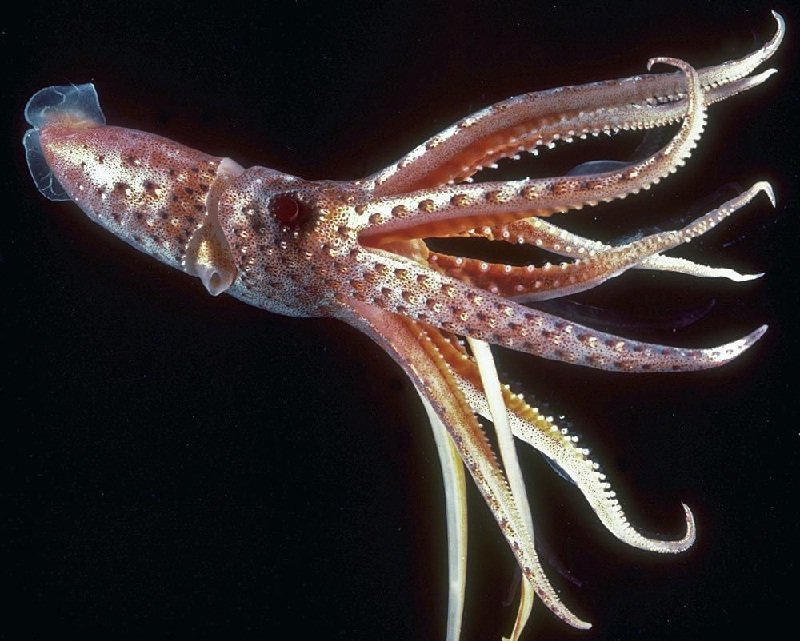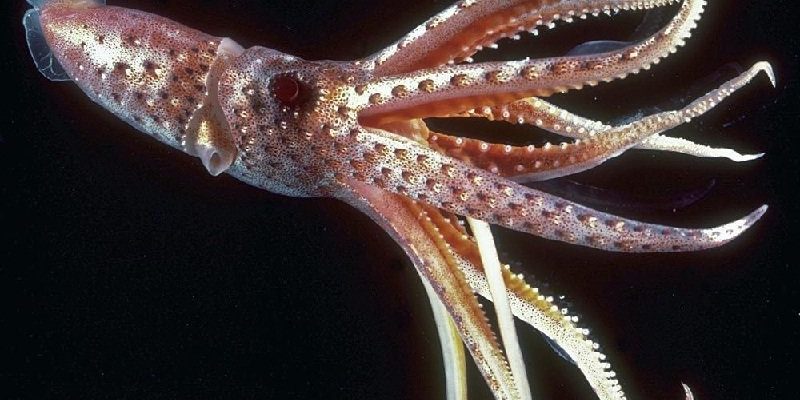
Introduction to the Umbrella Squid
Have you ever heard of the Umbrella Squid? These fascinating creatures are like the mysterious relatives of octopuses and cuttlefish, and they’re just as intriguing! Picture this: gliding through the ocean depths, this cephalopod displays a wide, umbrella-like body that captivates the imagination. With their remarkable adaptations, Umbrella Squids have evolved to thrive in the deep sea, where sunlight barely penetrates.
You might be wondering why they’re called “Umbrella Squid.” Well, it’s actually quite fitting! Their bodies resemble an umbrella when they spread their fins, creating a stunning display. These squids are not just beautiful; they have a variety of behaviors and features that help them survive in their underwater world. From their unique hunting techniques to their vibrant colors, there’s so much to explore about these captivating creatures.
Let’s dive into the world of the Umbrella Squid, learning about their habitat, diet, and some of the incredible adaptations that define them. Trust me, by the end, you’ll see why they hold a special place in the hearts of marine enthusiasts and curious minds alike!
Physical Characteristics
Umbrella Squids are known for their distinctive shape and appearance. These cephalopods have a broad, umbrella-like mantle that gives them their name. This unique shape is not only striking but also beneficial for their lifestyle. The umbrella can be expanded or contracted, allowing them to maneuver gracefully through the water.
In terms of size, Umbrella Squids typically range from about 30 to 60 centimeters (1 to 2 feet) long. Their bodies are slender and streamlined, aiding in swift movement. They have eight arms lined with suckers, and two long feeding tentacles that can extend to grab prey. The skin of these squids is often a mix of vibrant colors and patterns, thanks to special cells called chromatophores. These changes not only help them communicate but also assist in camouflage.
One fascinating feature is their large eyes, which are adapted to detect light in the dark depths of the ocean. These eyes can be up to 12 centimeters (about 5 inches) in diameter! Imagine having the ability to see in near darkness; it’s essential for locating food and avoiding predators.
Habitat of the Umbrella Squid
You might be surprised to learn that Umbrella Squids are found in deeper waters, typically residing between 200 to 1,000 meters (656 to 3,280 feet) below the ocean surface. They have a preference for oceanic environments, often inhabiting continental slopes and deep-sea regions. This is where the light barely reaches and where many of their fascinating behaviors unfold.
The ocean floor is a world of wonders, and Umbrella Squids have adapted remarkably to thrive in such conditions. They prefer areas rich in nutrients, which often attract their prey. The cold, dark waters can seem desolate, but they are home to a variety of organisms that play a crucial role in the marine food web.
Interestingly, these squids are also known to undertake vertical migrations. At night, they ascend to shallower waters to hunt for food. During the day, they return to the depths to avoid predators. This behavior allows them to balance their need for food with the ever-present threat of larger marine animals.
Diet and Feeding Habits
What do Umbrella Squids eat, you may ask? Well, their diet primarily consists of small fish, crustaceans, and other marine invertebrates. Equipped with specialized tentacles, these squids are formidable hunters. They can quickly extend their long feeding tentacles to capture prey with precision.
Their method of hunting is quite fascinating. Umbrella Squids often rely on stealth; they blend into their surroundings using their changing colors and camouflage abilities. Once they spot a potential meal, they can strike with lightning speed. This quick and efficient feeding technique allows them to thrive in the nutrient-rich waters they inhabit.
Additionally, their exceptional eyesight plays a major role in their hunting strategy. With their large, keen eyes, they can detect movement in the low-light environments of the ocean depths. This enables them to react promptly and secure their meals before the prey even realizes what’s happening.
Reproductive Behavior
Reproduction in the Umbrella Squid is as intriguing as the squids themselves. Like many cephalopods, they have a unique mating ritual. Males and females typically come together during specific times of the year, often synchronized with environmental cues like changes in temperature or food availability.
Once they mate, the female lays hundreds of eggs, which she carefully places on the ocean floor or attaches to underwater structures. After laying the eggs, the female often guards them diligently, ensuring their safety from predators. This protective behavior is crucial, as the eggs are vulnerable during this delicate stage.
After several weeks, the eggs hatch into tiny squids that are miniature versions of their adult counterparts. These hatchlings are initially on their own, facing the challenges of life in the ocean. They must quickly learn to navigate their environment, find food, and avoid becoming prey themselves.
Behavior and Adaptations
Umbrella Squids exhibit a range of remarkable behaviors that showcase their intelligence and adaptability. One of their most notable traits is their ability to change color and texture. This skill is not only used for camouflage but also serves as a means of communication with other squids. Whether it’s showing aggression or attracting a mate, these vibrant displays are an integral part of their social interactions.
In terms of movement, Umbrella Squids can propel themselves through the water by expelling water from their bodies. This jet propulsion allows them to make quick escapes from predators or catch up with fast-moving prey. When they feel threatened, they can also use ink as a defensive mechanism, creating a cloud that obscures their escape.
Furthermore, these squids have a fascinating relationship with their surroundings. They are known to use the ocean currents to their advantage, allowing them to conserve energy while drifting through the water. Adaptability is key to their survival in the fluctuating conditions of the deep sea.
Conservation Status
The conservation status of the Umbrella Squid is not well-documented, partly because of their elusive nature. However, like many marine species, they face threats from overfishing and habitat degradation. There’s an ongoing concern about the impact of human activities on deep-sea ecosystems, as these environments are still relatively unexplored.
While Umbrella Squids are not currently categorized as endangered, it’s vital to monitor their populations and habitats. Conservation efforts focused on sustainable fishing practices and protecting deep-sea environments play an essential role in ensuring the survival of not just Umbrella Squids, but countless other marine species.
Public awareness is equally important in the conservation of these fascinating creatures. By learning more about the Umbrella Squid and sharing that knowledge, we can help foster a greater appreciation for the delicate balance of marine life.
Interesting Facts about Umbrella Squids
Now that we’ve explored various aspects of the Umbrella Squid, here are some intriguing facts that may surprise you:
| Scientific Name: | Uroteuthis spp. |
| Size: | 30 to 60 cm (1 to 2 ft) |
| Habitat: | 200 to 1,000 meters (656 to 3,280 ft) deep |
| Diet: | Small fish, crustaceans, marine invertebrates |
| Life Span: | 1 to 2 years |
| Color Change: | Uses chromatophores for camouflage |
| Movement: | Jet propulsion and fin swimming |
As you can see, Umbrella Squids are remarkable not just for their physical attributes but also for their unique lifestyles and adaptations. Their presence in the ocean adds a layer of wonder to the marine ecosystem.
FAQ
What is an Umbrella Squid’s primary habitat?
Umbrella Squids primarily inhabit the deeper parts of the ocean, usually between 200 and 1,000 meters. They favor continental slopes and deep-sea areas where they can find abundant food sources. This environment, characterized by cold temperatures and low light, suits their unique adaptations perfectly.
How do Umbrella Squids capture their prey?
These squids use a combination of stealth and speed to catch their meals. They blend into their surroundings using color and texture changes, allowing them to surprise unsuspecting prey. When they strike, their long feeding tentacles extend rapidly to ensnare small fish or crustaceans.
Do Umbrella Squids have any natural predators?
Yes, Umbrella Squids are preyed upon by larger marine animals, including fish, whales, and other cephalopods. Their ability to blend into the ocean and use ink for escape helps them evade these dangers. However, they remain vulnerable, especially when they are young.
What is the lifespan of an Umbrella Squid?
Umbrella Squids typically live for about 1 to 2 years. Their life cycle is relatively short, and they go through various stages of growth quickly. After hatching, they must rapidly adapt to their environment to survive.
Are Umbrella Squids social creatures?
While Umbrella Squids may exhibit some social behavior during mating, they are generally solitary animals. They prefer to hunt and live alone, relying on their adaptability and camouflage skills to navigate the challenges of deep-sea life.
How do Umbrella Squids communicate?
Umbrella Squids communicate primarily through color changes and body language. By expanding or contracting their bodies and altering their colors, they convey emotions or intentions to potential mates or rivals. This visual signaling is essential for their social interactions.
Can Umbrella Squids change their color?
Absolutely! Umbrella Squids possess specialized cells in their skin called chromatophores, which allow them to change color and blend into their surroundings. This ability is not only useful for hiding from predators but also plays a role in communication.
Why are Umbrella Squids important to the ecosystem?
Umbrella Squids play a vital role in the marine food web. As both predators and prey, they help maintain the balance of species in their habitat. Their presence supports a range of marine life and contributes to the health of ocean ecosystems.
Are Umbrella Squids endangered?
Currently, Umbrella Squids are not classified as endangered. However, like many marine species, they face threats from overfishing and habitat loss. Conservation efforts to protect their habitats are critical for their ongoing survival.
Where can I see Umbrella Squids?
Seeing Umbrella Squids in the wild can be challenging due to their deep-sea habitats. However, some aquariums feature them in exhibits or educational programs. Participating in marine exploration or research expeditions can also provide opportunities to observe these fascinating creatures in their natural environment.

